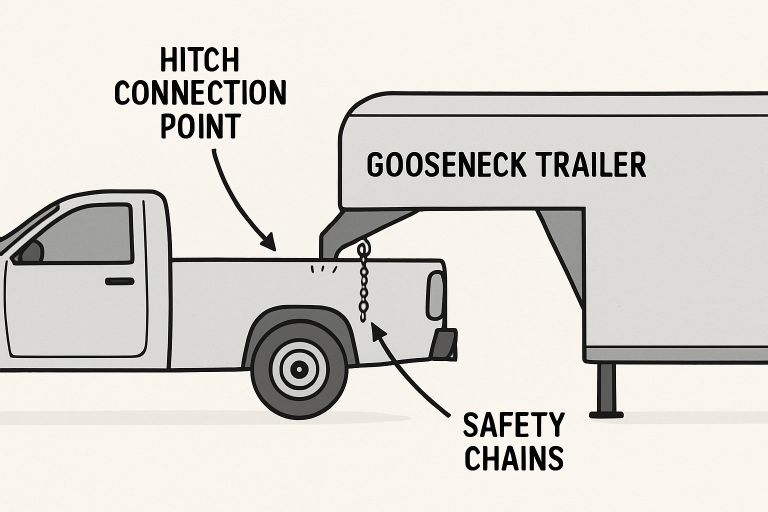Safe Towing with Gooseneck Trailers: Tips for Every Hauler
Towing with gooseneck trailers has become the top choice among professionals and everyday haulers, thanks to their stability and ability to carry heavier loads than traditional trailer configurations. Understanding proper practices and using carefully engineered gooseneck hitches can significantly improve safety and ease of transport. Whether you’re hauling livestock, heavy machinery, or recreational vehicles, following best practices to reduce risks and make every trip as seamless as possible is essential.
Equipping your tow vehicle with the right hitch system isn’t just about convenience — it’s a critical factor in safety and road handling. Gooseneck trailer setups, especially when paired with reliable gooseneck hitches, offer smooth weight distribution, enhanced stability, and superior maneuverability compared to bumper-pull trailers. However, mastering these systems requires understanding their unique demands and regular attention to your equipment and driving techniques.
Understanding Gooseneck Trailers
Gooseneck trailers connect through a specialized hitch mounted in the bed of a pick-up, arching over the rear axle instead of attaching at the bumper. This configuration lets the trailer distribute weight evenly across the vehicle’s frame, leading to better stability and less trailer sway at high speeds. In addition, because the hitch point is centralized over the axle, drivers benefit from improved maneuverability, tighter turns, and greater control when navigating corners or reversing.
The proper operation of gooseneck trailers depends largely on careful attention during hitching. Always inspect that the kingpin is securely locked into the coupler and that safety chains and breakaway cables are correctly attached. Taking the time to become familiar with these fundamental aspects helps prevent disconnections or malfunctions that could otherwise result in hazardous situations. For the highest safety standards, only use equipment that matches your vehicle’s weight rating and intended loads, consulting manufacturer guidelines when in doubt.

Pre-Trip Inspections
Accidents and breakdowns are often preventable with a thorough inspection routine before every haul. Focus on these critical areas:
- Tires: Confirm all tires on both the trailer and the towing vehicle are correctly inflated. Check for signs of cracking, bald spots, or damage that could lead to blowouts on the road.
- Brakes: Test all braking systems, including trailer brake controllers. Fully functioning brakes control a loaded trailer’s momentum, especially on inclines or during emergency stops.
- Lights and Signals: Ensure every external light, brake light, and turn signal operates as required. Visibility is crucial for communicating with fellow drivers and complying with roadway regulations.
- Hitch Connection: Double-check the coupler’s engagement, safety chains, and wiring harness. Even minor lapses in securing these elements can lead to equipment failure and dangerous detachments.
The Occupational Safety and Health Administration (OSHA) provides guidelines for a comprehensive pre-trip inspection checklist.
Safe Driving Practices
Once you’re on the road, towing a gooseneck trailer demands sharper awareness and additional precautions compared to everyday driving. Key tips include:
- Speed Control: Obey all posted speed limits for safety and compliance with legal restrictions that often apply to trailers. Reducing speed provides more reaction time to unpredictable events and helps prevent loss of control.
- Following Distance: Heavy loads mean longer stopping distances. Maintain a wider gap between your vehicle and others ahead to buffer against sudden stops or emergencies.
- Turning Techniques: Because gooseneck trailers swing in a broader arc, be conscious of your trailer’s rear end when turning, ensuring clear curbs and obstacles. Practice slow, deliberate turns whenever possible.
- Handling Sway: If you feel the trailer beginning to sway, do not accelerate or make sharp steering corrections. Instead, ease your speed gradually and try to stay in a straight line until the sway subsides.
Anticipate longer braking distances and consider using trailer brakes with your vehicle’s system, especially on downgrades or wet pavement. When changing lanes, always double-check blind spots using extended mirrors and allow ample space for your rig and trailer to maneuver safely.
Regular Maintenance
Preventive maintenance is fundamental for avoiding mechanical failures and extending the lifespan of your towing setup. Core tasks include:
- Lubrication: Routinely grease hitch components, couplers, and moving suspension parts to minimize friction and slow wear. Excessive squeaking or stiffness often indicates it’s time for fresh lubricant.
- Inspection: At regular intervals, examine the trailer frame, axles, and leaf springs for cracks, corrosion, or other signs of fatigue. Tighten any loose bolts and replace worn parts immediately.
- Cleaning: After any trip—especially if you’ve hauled in rainy, snowy, or salty conditions—wash down the trailer to remove grime and prevent rust. Keeping running gear and undercarriages clean helps ensure long-term function and safety.
Also, maintain the electrical and hydraulic systems according to the manufacturer’s instructions, and document all maintenance to keep track of servicing schedules and parts replacements.
By making these checks and habits routine, you’ll safeguard yourself and others on the road and protect your investment in equipment and cargo for years to come.
Visit the rest of the site for more interesting and useful articles.

